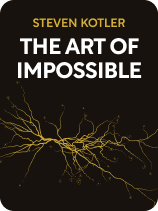

This article is an excerpt from the Shortform book guide to "The Art of Impossible" by Steven Kotler. Shortform has the world's best summaries and analyses of books you should be reading.
Like this article? Sign up for a free trial here .
How can you be more engaged in your goals when you feel unmotivated? How does practicing full engagement help you succeed?
In The Art of Impossible, peak performance expert Steven Kotler draws on extensive neurobiological research to demystify the path to breakthrough success. Kotler focuses on a scientific way to be more engaged, including how the neurochemistry of your brain affects engagement, motivation, and overall happiness.
Read on to learn how to be more engaged in your goals (and feel good!), according to Kotler’s scientific approach.
How to Be More Engaged: It’s All in Your Head
According to Kotler, elite performers achieve seemingly impossible feats because they consistently perform at the peak of their capabilities and push themselves to exceed their potential. How are they able to maintain this level of commitment? Kotler argues that it’s because their neurochemistry supports their high-performance habits.
We’ll explain how to be more engaged with what you’re doing and why full engagement generates a combination of neurochemicals that enhances your capabilities and motivates you to achieve your goals.
How Neurochemicals Help You to Be More Engaged
While there are many neurochemicals in the body, each serving a different function, Kotler’s research focuses on the reward chemicals that come into play when peak performers rise to the height of their capabilities. He argues that peak performers feel motivated to challenge themselves and reach new heights because they find the process pleasurable. The process is pleasurable because it releases six different neurochemicals—thereby rewarding and reinforcing peak performers each time they engage in their high-performance habits:
- Dopamine: Focuses your attention, making you feel excited and engaged
- Norepinephrine: Boosts your energy and makes you feel more alert
- Oxytocin: Promotes feelings of love, trust, and empathy for others
- Serotonin: Elicits feelings of calm, contentment, and satisfaction
- Endorphins and anandamide: Induce relaxation by relieving feelings of pain and stress
It’s clear to see how each of the reward neurochemicals makes high-performance habits feel pleasurable. However, Kotler argues, generating one neurochemical at a time doesn’t provide enough motivation to sustain a peak performer’s momentum over the long term.
According to Kotler, the positive advantages of full engagement drive peak performers to continually improve themselves and do what it takes to achieve their goals. Therefore, if you want to adopt peak performance habits and achieve seemingly impossible goals, you must learn how to be more engaged.
| How to Be More Engaged According to Neuroscience Neuroscience research confirms Kotler’s assertion that regularly attaining a state of flow or full engagement is essential to maintaining peak performance habits. Likewise, it confirms that the only way to simultaneously produce all six reward neurochemicals is to achieve this mental state. Neuroimaging techniques—functional magnetic resonance imaging (fMRI) and electroencephalograms (EEG)—offer additional insights into how being fully engaged impacts the brain and creates the mental advantages Kotler describes: It slows down brain waves from beta (fast and erratic) to alpha (slow and free-flowing). This dramatically enhances your focus and concentration and makes tasks feel effortless—making those tasks more satisfying and arguably making you more productive. Intense concentration limits activity in the prefrontal cortex—the part of the brain that’s associated with self-monitoring, insecurities, and worries regarding everyday reality. This quiets your internal critic and promotes positive, non-judgmental thoughts—thus enhancing your relationship with yourself and others by making you more empathetic and able to collaborate with others. Limiting activity in the prefrontal cortex also limits the thoughts that keep you aware of everyday reality. This changes your perception of time and allows you to get lost or fully immersed in your tasks. Cognitive activity then moves to subcortical brain regions. This speeds up your brain’s ability to process information and sparks new connections and creative ideas that make it easier for you to expand your knowledge and learn new skills. |
Exercise: Practicing Full Engagement
According to Kotler, you’re more likely to practice full engagement and achieve your seemingly impossible goal if you feel intrinsically motivated to achieve it. This exercise walks you through the process of choosing an appropriate goal when learning how to be more engaged.
- Write down at least five things that you’re interested in learning more about. Be as specific as possible.
- Look for areas where two or more of your interests share common ground or complement each other. Link them together to create a new area of interest.
- Write down at least five global problems that you care about. Be as specific as possible.
- Consider how your interests could potentially solve one of these global problems. Briefly describe these possible solutions.

———End of Preview———
Like what you just read? Read the rest of the world's best book summary and analysis of Steven Kotler's "The Art of Impossible" at Shortform .
Here's what you'll find in our full The Art of Impossible summary :
- A look at how some people can achieve seemingly impossible feats
- How to make your dreams more attainable
- A step-by-step process for developing peak performance habits






